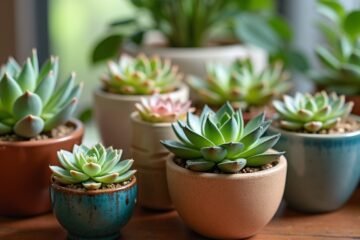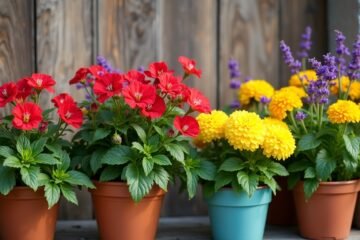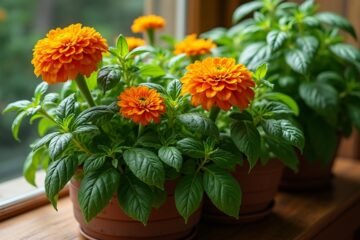Want a container garden that wows? Pairing flowers is your secret weapon! Think marigolds dancing alongside tomatoes, keeping pesky critters at bay! Or how about zinnias attracting butterflies while vibrant pansies cheerfully bloom? Remember to mix heights and textures for that professional touch—like a painter splashing colors on a canvas! Just avoid mismatched partners, or your flowers might sulk. If you’re keen for more tips to create your blooming masterpiece, there’s plenty of fun ahead!
Understanding Companion Planting Principles
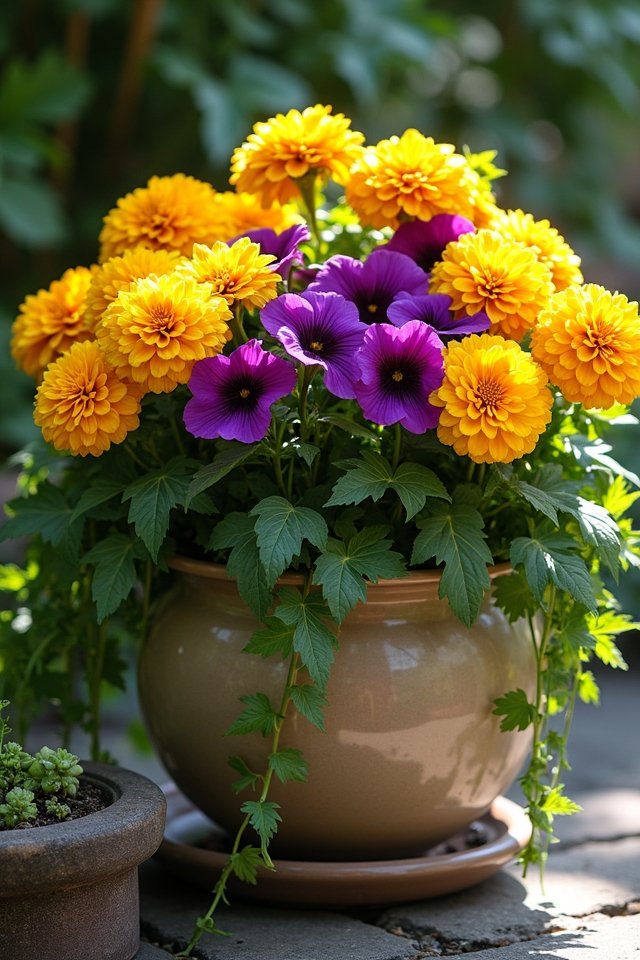
When it comes to companion planting, you might be surprised to learn that flowers can be just as good for each other as peanut butter and jelly! Imagine pairing marigolds with zinnias. Marigolds offer pest protection while zinnias attract pollinators—talk about a dynamic duo! Understanding companion plant benefits is essential; flower compatibility can transform your container garden into a vibrant spectacle. Think of it like a concert where each bloom plays its part. You wouldn’t let an off-key singer ruin the show, right? Similarly, mismatched flowers can stifle growth! Welcome the creativity—choose partners that enhance each other’s charms. You’ll love the way your container garden flourishes, showcasing colors and fragrances that dance together in perfect harmony!
Selecting the Right Flowers for Your Climate
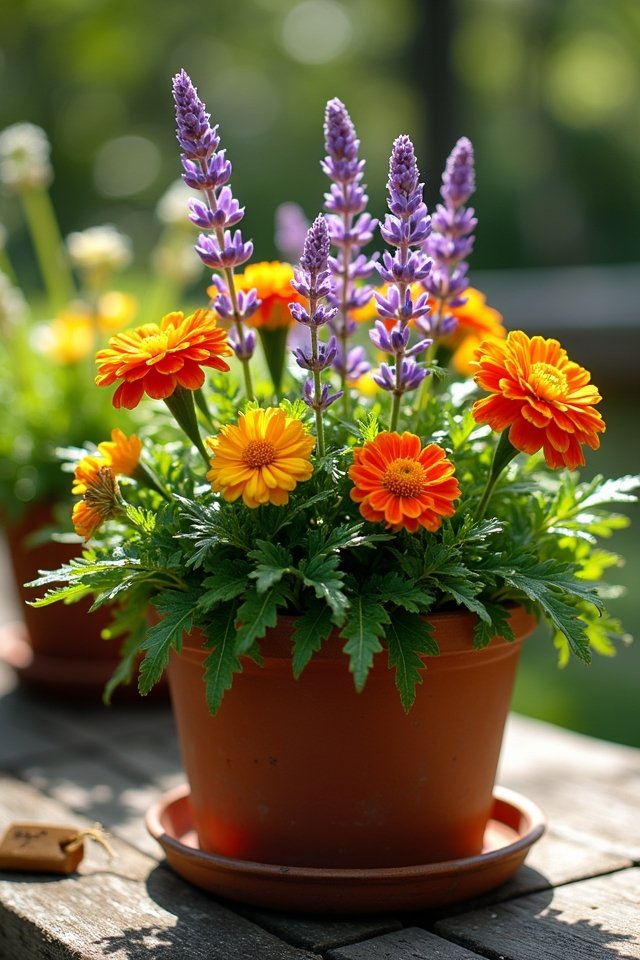
Choosing the right flowers for your climate can feel a bit like finding the perfect dance partner; you want someone who moves in sync with you! Begin by checking your climate zones and hardiness ratings—these factors play a huge role in your floral success. For instance, if you live in a warm area, consider sun-loving beauties like marigolds or zinnias that’ll bask in the sun’s glow. Conversely, cooler climates can thrive with vibrant pansies or hardy chrysanthemums. Remember, adapting your flower selections to local conditions isn’t just smart—it’s like giving your garden a little high-five! So, take the time to research, and you’ll be rewarded with a breathtaking container garden that harmonizes beautifully with your unique environment!
Designing Aesthetic Combinations for Container Gardens
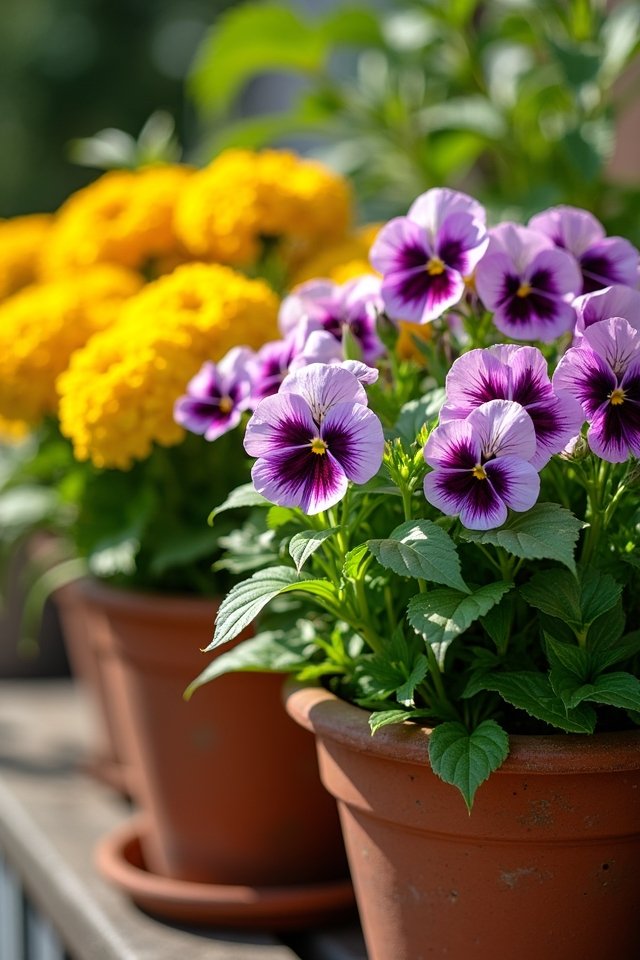
Designing the perfect aesthetic combination for your container garden can feel as rewarding as creating a vibrant work of art! You’ll want to capture attention and evoke emotion through your choices. Here’s how to do it:
- Explore Color Theory: Combine warm and cool hues for stunning contrasts—think orange marigolds with blue lobelia.
- Focus on Seasonal Blooms: Pair cherries and peaches—summer blossoms like zinnias with autumn’s rich chrysanthemums.
- Use Texture: Mix smooth petunias with feathery ferns for delightful tactile variety!
- Consider Height Variation: Create visual intrigue by placing tall sunflowers behind short daisies.
With these tips, your container garden will surely stand out like a masterpiece—so go ahead, release your creativity! Are you ready to transform your outdoor space?
Enhancing Plant Health With Complementary Species
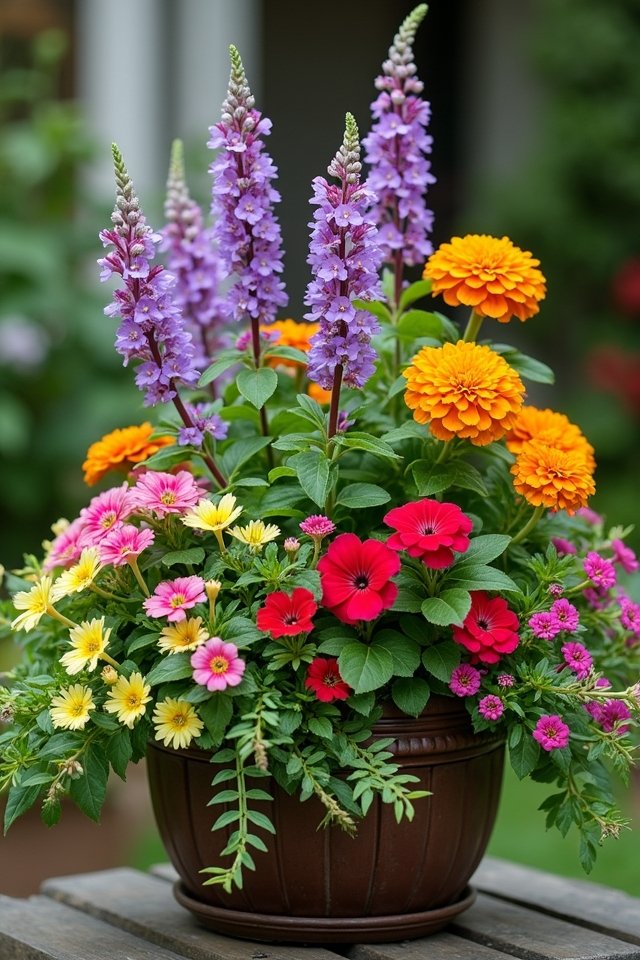
To truly boost the health of your container garden, consider planting complementary species that work together like the best of friends! Imagine vibrant marigolds hugging your tomatoes, attracting beneficial insects while deterring pesky pests. It’s like throwing a party where everyone brings their own delicious dish!
Mix in herbs like basil or parsley, which not only flourish next to veggies but also improve soil health by enhancing nutrient levels. With these dynamic pairings, plants thrive in a lively atmosphere.
You’ll notice their happy growth as they dance in the breeze, and you can’t help but smile! So, don’t just plant and forget—create a harmonious ecosystem, and watch your container garden blossom in ways you never thought possible!
Creating Layered Textures and Heights
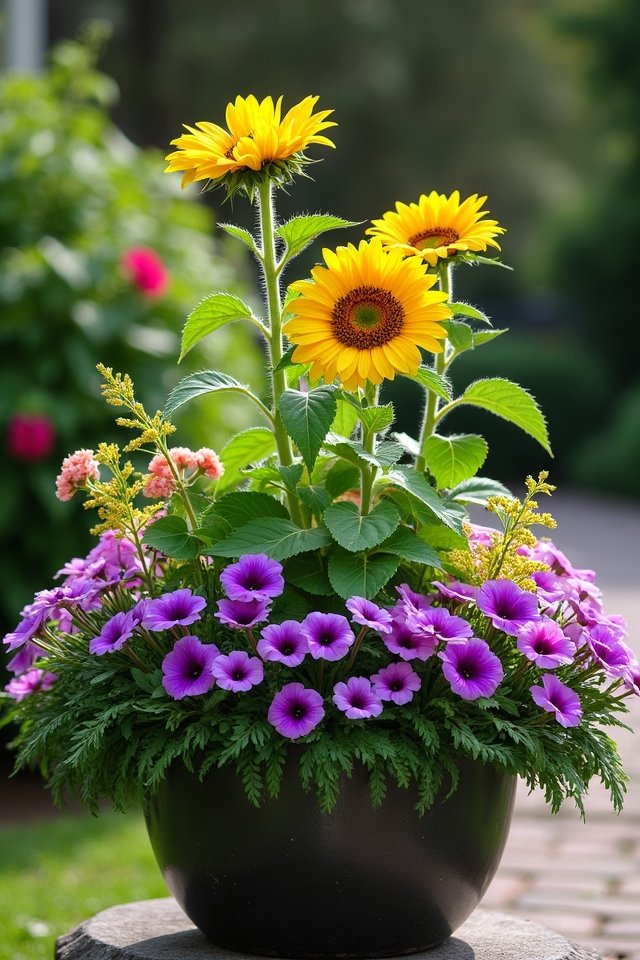
When you think about container gardens, you might not imagine the stunning beauty created by layered textures and heights! By incorporating height variations, you’ll elevate your garden’s visual interest instantly. Consider these four key elements for enchanting layered arrangements:
- Tall Focal Flowers: Start with dramatic blooms like sunflowers or delphiniums.
- Mid-Level Marvels: Add eye-catching plants like daisies or salvias to bridge the gap.
- Trailing Beauties: Hang cascading plants, like ivy or million bells, over the edges.
- Filler Fun: Use lush foliage or small flowers, like petunias, to fill in gaps.
Combining these elements leads to an exciting, eye-popping display that even Mother Nature would admire! What’s not to love about a little garden pizazz?
Timing and Seasonal Considerations
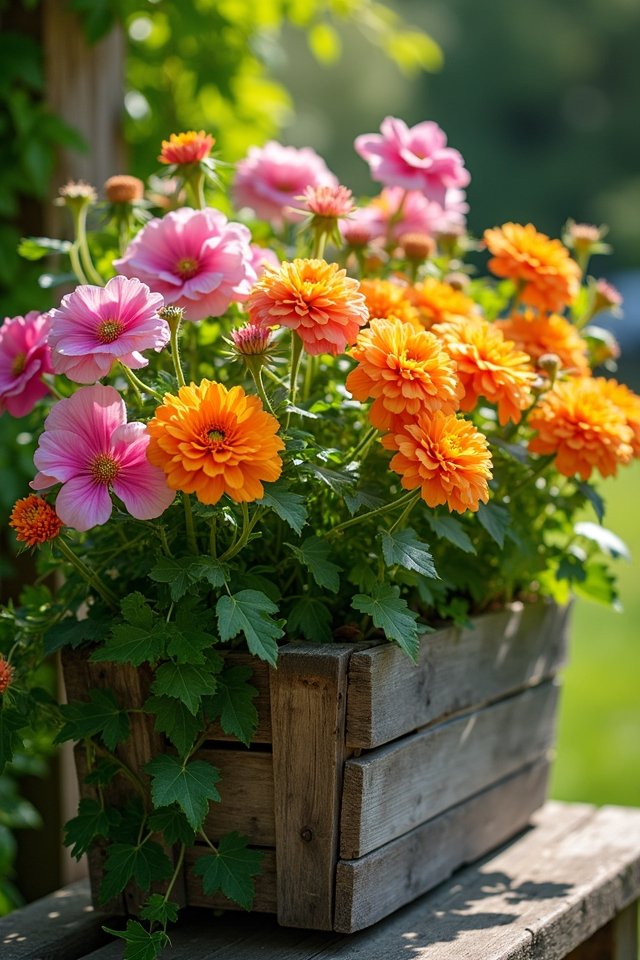
Timing your flower combinations perfectly can make all the difference in creating a container garden that dazzles! Imagine this: vibrant, seasonal blooms popping with color, arranged like a painter’s palette. To achieve that spectacle, you’ve got to pay attention to planting schedules. Think spring-flowering pansies and summer-showcasing petunias, beautifully intermingled. Each flower has its prime time to shine, so plan ahead! You wouldn’t wear flip-flops in snow, right? Similarly, choose flowers that thrive in your specific season. For a striking vertical display, pair early-blooming daffodils with late-summer zinnias for a seamless shift. Keep an eye on temperature too; it can make or break your garden’s glam! So, are you ready to make some floral magic happen? Let’s dig in!
Maintenance Tips for Mixed Flower Containers
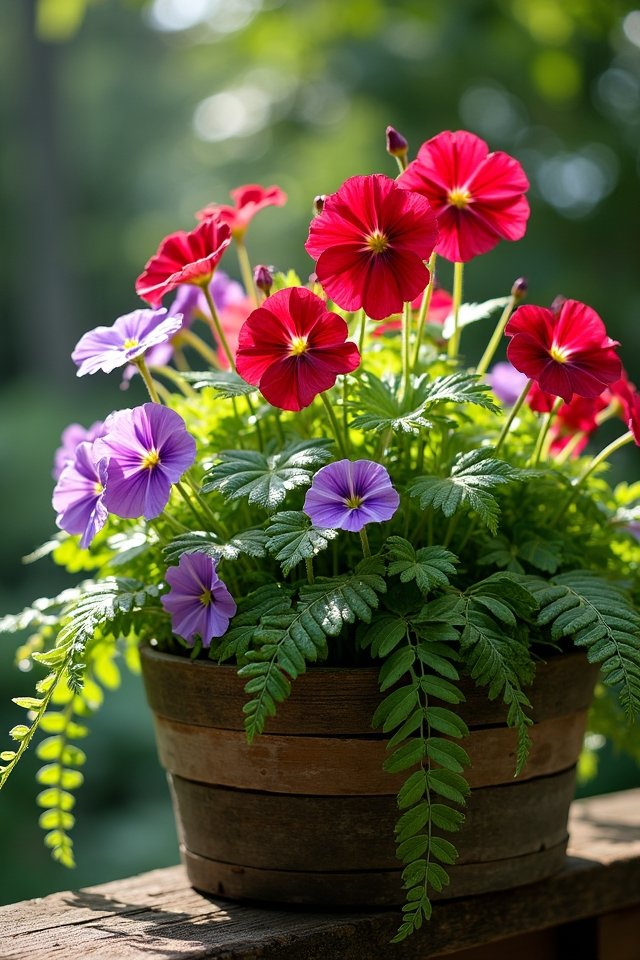
Creating stunning mixed flower containers isn’t just about the pretty blooms; keeping them healthy and vibrant is just as important! Here are four maintenance tips to guarantee your floral masterpiece keeps shining:
- Watering Techniques: Consistent moisture is key! Use deep watering to encourage strong root systems—treat your flowers like a thirsty friend!
- Fertilizer Options: Feed your blooms with a balanced, slow-release fertilizer every six weeks. Think of it as a gourmet meal for your plants!
- Pruning: Snip dead flowers and yellowing leaves regularly. It’s like giving your garden a fresh haircut!
- Pest Control: Stay vigilant! Inspect your flowers for pests and treat them immediately. No one likes uninvited guests!
Common Mistakes to Avoid in Pairing Flowers
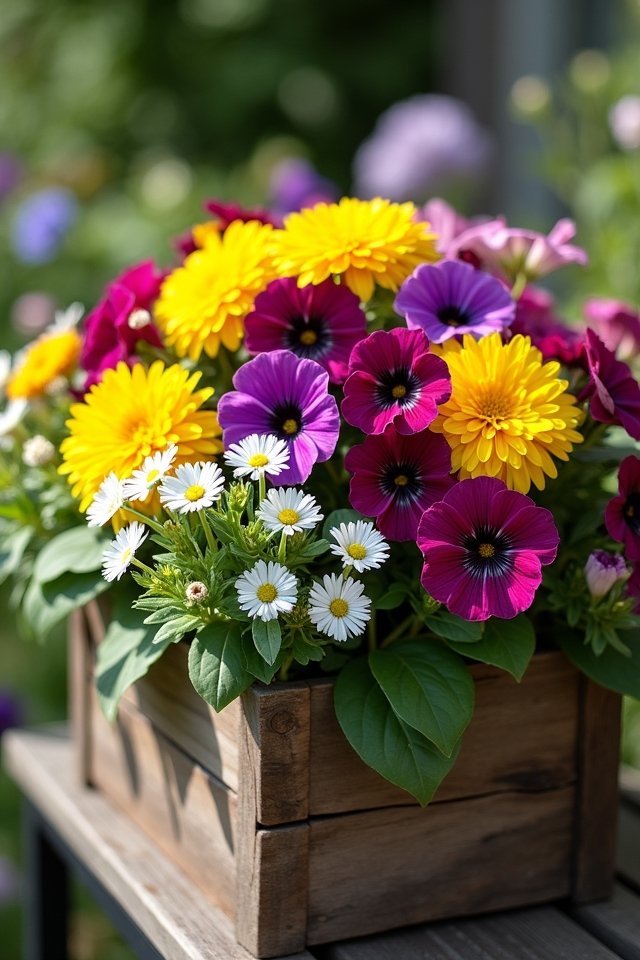
While you might think pairing flowers is a straightforward task, a few common mistakes can leave your container garden looking less than fabulous. First off, be wary of flower color clashes! Imagine vibrant yellows dancing with muted browns—it just doesn’t work. Instead, aim for complementary colors that sing together!
Next, consider growth rates; you don’t want your short, sweet daisies squished beneath towering sunflowers! Mixing incompatible growth rates can turn your garden into a chaotic jungle.
To avoid regret, do your research. When in doubt, pair a slow-grower, like petunias, with the quick-to-spread marigolds! This harmonious pairing creates a visual feast that’s nothing short of gardening magic! So go on, and design your floral masterpiece with confidence!
Frequently Asked Questions
How Do I Select the Right Container Size for My Flowers?
Choosing the right container size is like picking a cozy apartment for your flowers! Aim for depth—at least 12 inches for deeper roots to flourish. Drainage holes are your flower’s best friend; without them, their roots might drown like a fish out of water! Consider the plant’s size, too. A compact blossom needs less space than a grand sunflower! So, pick wisely, and your garden will thank you with a vibrant explosion of color!
Can I Use Edible Flowers in My Container Garden?
Absolutely, you can use edible flower varieties in your container garden! Imagine plucking vibrant nasturtiums, their peppery flavor adding zest to your salads. Or think about sweet pansies, perfect for garnishing desserts—talk about a conversation starter! These colorful blooms not only elevate your meals but also your garden’s beauty. So, why not spice things up? Your taste buds and guests will thank you, and who doesn’t love a garden that looks good enough to eat?
What Are the Best Soil Types for Container Flowers?
When you’re choosing soil types for container flowers, think cozy homes! A high-quality potting mix is your best friend—it’s light, fluffy, and perfect for soil drainage. Imagine your flowers sipping water without drowning! Look for a blend that includes perlite or vermiculite for extra aeration. You wouldn’t want your plants stuck in soggy mess, right? It’s all about creating a happy, thriving environment for those blooms to shine. Let’s dig into success!
How Often Should I Fertilize My Container Plants?
You should fertilize your container plants every 4 to 6 weeks during the growing season. Think of it as giving them a little energy drink! Use slow-release fertilizer types for continuous nourishment, and don’t forget to pay attention to nutrient timing—plants love a well-timed meal! If you notice yellowing leaves, it’s a hint they need a boost. Remember, ready, set, grow—your vibrant blooms await! Happy gardening!
Is It Necessary to Deadhead Flowers in Containers?
Did you know that deadheading can boost a flower’s longevity by up to 30%? That’s like putting a fresh battery in your favorite toy! By using simple deadheading techniques, like snipping off spent blooms, you’ll encourage new flowers to sprout. It’s like having a cheerleader for your plants! Don’t overlook this easy task—your vibrant blooms will thank you by continuing to dazzle all season long. Isn’t that worth a little snip?
